Introduction
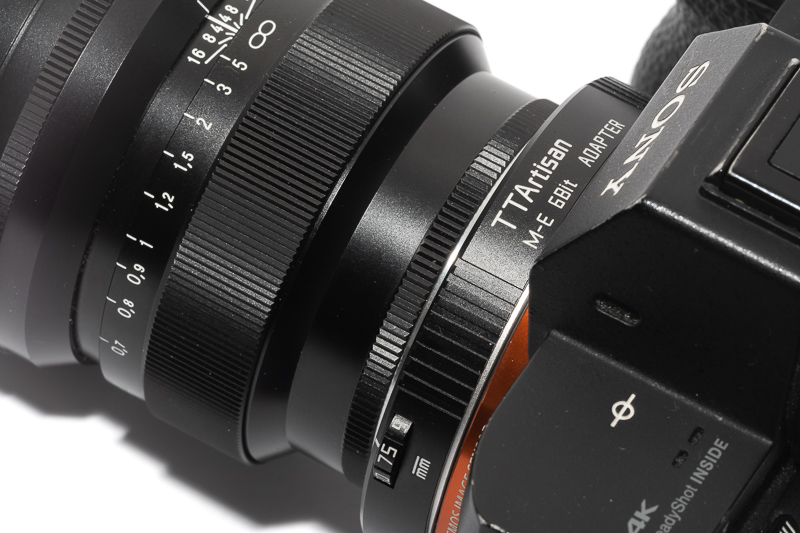
Since I bought my first E-mount camera seven years ago I have been using adapted M-mount lenses. Missing Exif data have always been a nuisance though and while the “Lens Compensation” camera app was a ray of hope, it didn’t exactly work all that well.
Now TTArtisan came up with a product which I have pitched to so many manufacturers before: a semi programmable Leica-M to Sony-E/Nikon-Z adapter. Let’s have a closer look!
Update August 2024: more information on the version for Nikon Z-mount (affiliate link) added
Contents
How does it work?
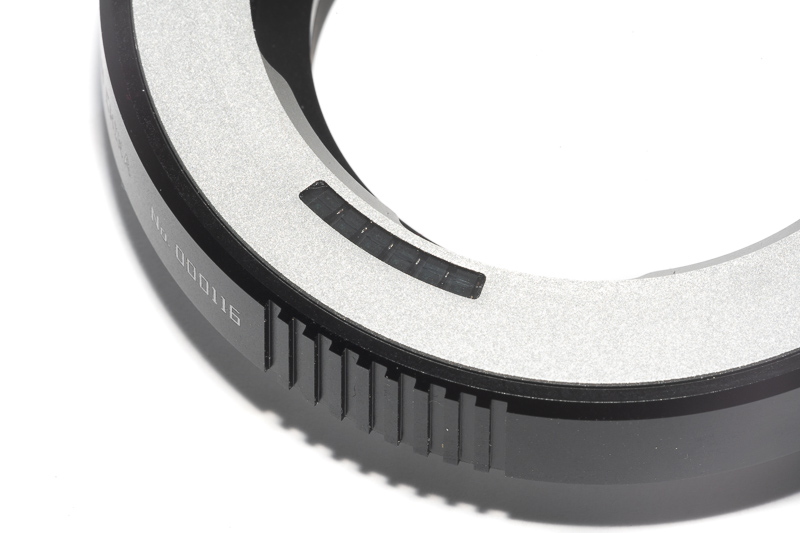
The TTArtisan 6-bit Adapter comes in two versions, one for Sony E-mount cameras and one for Nikon Z-mount cameras. These adaters let you use your Leica M lenses on a Sony E-mount/Nikon Z-mount camera – nothing special, adapters that can do that have been around since forever – but these ones have two additional functions:
a) they will translate the 6-bit codes on Leica M lenses to Sony/Nikon lens exif
b) if you use a lens without a 6-bit code you can set one of the typical Leica M focal lengths (28/35/50/75/90/135) via a small wheel
What are these 6-bit codes?
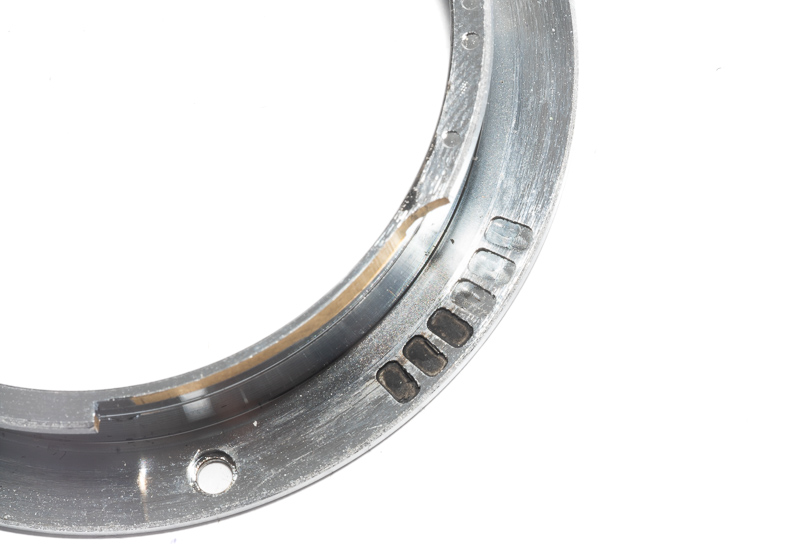
In 2006 with the introduction of the Leica M8 a 6-bit code system for M-mount lenses has also been introduced which allowed for the application of in camera correction profiles (which were badly needed when using some of the Leica M lenses on a digital camera) as well as additional lens exif data in the digital files.
If you are looking for a more detailed explanation have a look here.
Using 6-bit coded lenses
Now if you attach a lens equipped with a 6-bit code this adapter will translate this code to lens exif data the Sony/Nikon cameras understand. Every lens will be registered in the exif data as “Leica M <focal length> <max. aperture>”, so you don’t get the lens name (like Summicron or Summilux) or anything additional. For example the Leica 90mm 2.0 Summicron-M will show up as “Leica M 90mm F2.0”.
You can use the aperture wheel on the camera to change the aperture value which will be written in the exif data. So if you want to track at which aperture values you shot this is a handy feature.
When you put a lens with a different 6-bit code (or you use the wheel on the adapter to change the focal length) you have to detach the adapter from camera first for these changes to be registered. Pressing the lens release button and slightly rotating the adapter back and forth is sufficient here.
Update: the Mark II E-mount version of this adapter and also the Z-mount version feature a small reset button, if you change the lens just press it and you are good to go.
Using lenses without 6-bit code
If you are using a lens without a 6-bit code the adapter will use the focal length you set on the small wheel on the side of the adapter. Only the six typical Leica focal lenghts are included though: 28, 35, 50, 75, 90 and 135mm.
Here the lens name will be registered as “Leica M <focal length> F1.0”, you can use the aperture wheel on the camera again to have any aperture value between f/1.0 and f/16 written in the exif data.
The focal length set will also be passed on to the IBIS setting to allow for the correct amount of stabilization.
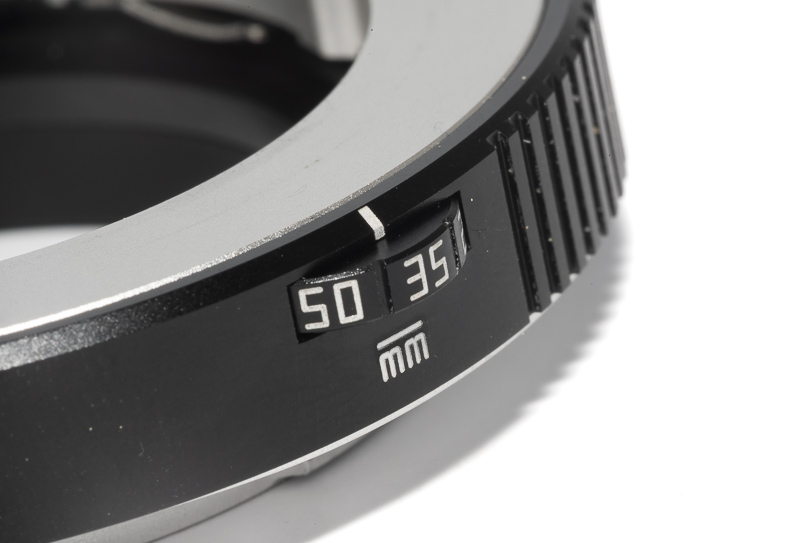
Update: the wheel on the Mark II E-mount version as well as on the Nikon Z-mount version of this adapter features click-stops, so it is less likely to accidentally change the setting.
Compatibility
I already received a pre production sample before and there were two things I didn’t like about it: the opening of the adapter was too small, so I encountered additional vignetting with many fast and/or longer lenses and it only really made sense if you had 6-bit coded lenses.
As said before we got a wheel to set the focal length now and I am also happy to report: the opening got much bigger.
With the pre production sample I encountered severe vignetting with the Leica 90mm 2.0 pre Asph, the MS-Optics 135mm 2.4 and light vignetting with the MS-Optics 50mm 1.0 and the VM 75mm 1.5. All of these – except for the MS-Optics 135mm 2.4 – work flawlessy now without additional vignetting.
There are some more lenses with a big entrance pupil I think might encounter some issues but I don’t have them here to check: Leica/7Artisans 75mm 1.25, Leica/Zhong Yi 90mm 1.5, TTArtisan 90mm 1.25 and the 50mm f/0.95 lenses.

Out of all my M-mount lenses I also had issues with the Leica 90mm 2.0: when using the original uncoded bayonet one of the screws is being recognized as a “1” and therefore the adapter thinks you are using a Leica 90mm 2.8.
This adapter is also a little bit on the short side, so might not be the greatest choice if you want to use a lens with a floating elements design. On the other hand it could therefore be a great choice if you are looking for an adapter to use with your Voigtlander VM 35mm 1.7 + 5m PCX filter…
By the way, this adapter only weighs 42g.
Update: the opening of the Mark II version is exactly the same as that of the Mark I version. Despite Z-mount being noticeably wider than the E-mount the opening of the E and Z versions is the same. I measured the weight to be slightly lower at 39g.
E-mount MKII and Z-mount versions also ship with an USB-C Dock that allows to update the adapter’s firmware in case there are compatibility issues with future cameras.
The Mark II E-mount version also has shims on the inside, so if you are a bit of a tinkerer you can calibrate its flange focal distance.
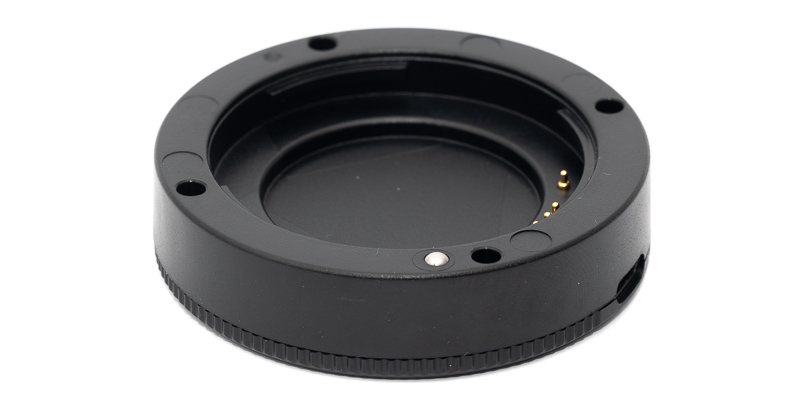
The Z-mount version of this adapter has an additional benefit: it allows to make use of the improved manual focusing aids for lenses with electronic contacts, which is especially valuable when using a Nikon Zf or Z6III.
Conclusion
I have been waiting for this for a long time and I wish it had been available sooner as it would have made my life reviewing lenses so much easier.
I don’t have any real complaints this time – except for the vignetting with the obscure MS-Optics 135mm 2.4 – and I usually don’t say this, but: if you are using M-mount lenses with 28/35/50/75/90/135 mm – or you are using 16/18/21/24 mm lenses and don’t mind to code them yourself – get one of these adapters.

Update: the MK II adapter has some useful improvements, the price stayed the same and I also like its all black color. In the TTArtisan shop it already replaced the MKI version.
Now that we already have the USB-C dock for firmware updates I (again) pitched the idea to TTArtisan to offer a software that allows you to map different unique Exif data to the 6 focal length settings on the wheel to support all kinds of lenses. Unfortunately there is no plan to offer such a software at this point. If you also think this would be useful please consider telling them on their Facebook or Instagram account. If we are enough maybe we can make it happen.
You can already order the improved MKII version from the official TTArtisan shop or from ebay.com for ~$75 (affiliate links)
A version for Nikon-Z cameras has also been released and can be bought from the official shop as well (affiliate link)
Further Reading
- Sony FE lenses: Our comprehensive and independent guide
- Sony FE lenses: Our guide to ultra wide angle lenses
- Review: Sony FE 85mm 1.4 GM
- Review: Voigtländer 50mm 1.2 Nokton E
Support Us
Did you find this article useful or just liked reading it? Treat us to a coffee!
![]()
![]()
![]() via Paypal
via Paypal
This site contains affiliate links. If you make a purchase using any of the links marked as affiliate links, I may receive a small commission at no additional cost to you. This helps support the creation of future content.
Latest posts by BastianK (see all)
- 2025 – Year in Review - December 23, 2025
- Review: Sony FE 70-200mm 4.0 G Macro OSS II - December 20, 2025
- Review: Viltrox AF 35mm 1.2 FE LAB - December 17, 2025
Great News! Did i miss it or didnt you write how heavy the Adapter is? For me this would be an important information. If it isnt much heavier than a normal metabones/fotodiox whatever adapter this would be a no brainer for me. On the contrary the vm close focus adapter is too heavy for my taste.
Thank you Bastian for keeping up the Testung and reviewing! Its an Amazing and reliable source of Information. Very grateful for this!
I measure 42g, so it is pretty light, too.
If this was available for Nikon Z mount, I would already have bought it!
I already have two AF adapters for my Nikon Z cameras, but to be honest, the AF functionality is not that great anyway. Getting properly working IBIS and full EXIF data is all I need and want.
Perhaps you could stack it with a Techart TZE-01 adapter?
In theory, yes, but Techart has previously said that you can’t stack their TZE-01 adapter with their Leica M to Sony E autofocus adapter, so I doubt it will work with this one.
There are 1 or 2 adapters from Leica to Sony that allow you to take manual focus lenses and make them AF via it moving the entire lens forward and backwards to focus. Have you looked into these?
This adapter is cool, but I don’t think I would use it since I have a helicoid adapter
Phillip has, they are not very durable.
Used it for almost 5 years now, no problem. I can’t guarantee that it would work until the end of time but I doubt my copy would break anytime soon.
What would I do for a Leica M to Sony E adapter that has electronic contacts to transmit Exif data. Plus Bluetooth and an App where all my lenses are stored with every detail. Even better would be RFID on the lenses and a reader in the adapter so the lens is automatically recognized when it’s attached. Let’s team up for a Kickstarter;-)
It seems that you could also have a sensor that contacts the rangefinder cam as well to transmit the focus distance. But definitely having the focal length available will be a huge win, just to get IBIS without monkeying string with the menu system.
Hi Bastian,
Love the thorough review & I have never been this excited for an adapter before 🤣 (may finally justify myself buying the CV 75/1.5)
A quick check, does the adapter trigger the auto magnification function when manual focusing?
Cheers!
It doesn’t, because the adapter doesn’t know if you touch the focus ring of your lens.
Ah I see, quite a pity but thanks for the clarification!
This is fantastic! I have been wanting something like this since I started adapting lenses. Now here is my thought:
Please offer additional adapters from popular SLR mounts (m42, Nikon, Canon, etc.) to Leica M with programmable 6-bit M bayonets so that I can have one each on my most used lenses, and combine them with this adapter to have a comprehensive, easy to switch, system.
Thank you Ttartisan!
Simply get hold of an M42, Nikon, Canon FD, CY, Leica R, etc. to Leica M adapter. You just stack two adapters that way. You have double the chance of misalignments or imperfect length, but that’s easy to check for.
Shipping to the US/California was $30. Hopefully that is an express service!
Sounds like it will be FedEx.
Do you think there any chance they will make these for the Z mount?
If this one is a success I am pretty sure there will be more.
My fingers are crossed, I would love one of these. I think the price is very reasonable for what it provides. Also, thanks for all the great content Bastian, it looks like you are doing the heavy lifting lately and it is appreciated!
Great idea! That’s something I’m missing on the Techart pro 🙂 I think, however, that here backward compatibility (i.e. 6 bit coding) may be not worth pursuing as large fraction of M-lenses are actually not 6-bit coded, and number of lens which one can code is limited. A better option could be to build this thing around embedded RFID reader (there are ones small enough to fit in) and small tag stickers to put on a lens. The tag can then be programmed to contain full lens info not tied to existing 6bit codes and not only focal length. Perhaps even correction profiles could be coded in (matrices are fairly small), and rfid are easy to program by user… Of course, I’m not sure how feasible it is in terms of space, but this could be valuable even at the cost of enlarging adapter a bit.
Thanks for the review. I am tempted to get one for use with a dumb Leica M to Olympus OM adapter. The problem is that I use 21 and 24mm lenses. Given that dumb adapters often have the six dimples for the coding, I wondered how easy it would be to create the coding. Would painting the correct dimples matte black be sufficient? Would the white ones need painting too (Tipp-Ex perhaps)? Or is electrical conductivity that is detected? A couple of extra cheap adapters wouldn’t break the bank, and having each lens coded would be an advantage.
When you have an adapter with the six dimples it is super easy,
you only need to use matte black paint for the black ones, you can just leave the others blank.
That is when your adapter is shiny of course, when it is black (some are) you need to paint the white ones. Tipp Ex might not be a bad idea actually – not that I already tried it.
I shall try this when the adapter arrives.
Do we have any idea as to whether the adapter will read any of the 6 Bit encoded Leica R to Leica M adapters?
By the way, I have 2 of these coming- one from TTArtisan and one through eBay.
Rich
Can you tell me more about these 6 Bit Encoded Leica R to M adapters?
I don’t know about those and that would be rather helpful to answer the question.
Hi Bastian,
Below is a link to a review article with both Leica’s and Novoflex’s 6 Bit encoded adapters:
https://www.pebbleplace.com/reviews/rangefinder/leica_r_m_adapter/index.html
The adapters provide information to the Leica M cameras starting with the M240 with more information starting with the M10.
Below are links to both adapters for B&H Photo:
https://www.bhphotovideo.com/c/product/894873-REG/Leica_14624_R_Adapter_M.html
https://www.bhphotovideo.com/c/product/220122-REG/Novoflex_LEM_LER_Lens_Adapter_Leica_R_to.html
Rich
I wasn’t aware these R->M adapters already have a 6-bit code assgined to them.
I have honestly no idea what the adapter will make of that code!
If you get bonkers exif painting (or putting black tape) on the remaining white spot should be enough to set the appropriate focal length via the M->E adapter’s wheel.
An adapter arrived today and I tried it with a Zuiko lens and the OM-LM adapter that came with a Techart Pro adapter. This has a bare metal flange and I assumed that would work in “manual” mode. It did not. It changed the focal length randomly between 28 and 35mm, whatever setting I chose. But covering the dimples with a piece of white sticky paper (cut from the Fedex shipping label) worked and I could adjust focal length manually. I guess all the dimples really need to be painted white.
My plan, given that I am not using Leica lenses, is to use this adapter in manual mode for lenses in the 28-135 range, and then to mark up two cheap OM-LM adapters to use on 21 and 24mm lenses. But that requires buying some white paint, or TippEx.
It is odd getting used to using the camera’s aperture setting to do nothing other than record the aperture that is set manually on the lens (I am used to the Techart Pro, where aperture must be set to f2 to get the correct exposure) but it works.
Thank you, Bastian, for drawing attention to this gadget.
A final comment, after using it a bit more. I found using a white sticky label and marking the codes with a fine-tipped black marker pen was the most reliable way to do the codes. Paint really does have to be genuinely matte, and I found it harder to get it right.
My only issue with the adapter is that the dial for adjusting the focal length when in manual mode turns so easily that it is easy to turn accidentally. It would be good for it to be a bit stiffer. Click-stops would of course be ideal, but that is probably asking too much.
Anyone reading this probably knows about Lenstagger, but the combination of this adapter, the Lightroom library module and Lenstagger makes it really easy to keep track of what lenses have been used.
Does anyone know or has tested if this adapter enables gyro-stabilization, which can be applied by Catalyst Browse to video footage of newer Sony cameras?
Kind regards
Christoph
Hi Bastian,
thanks for getting my attention to this adapter, it really is something I have been looking forward to!
My plan is to use another Canon FD or Minolta MD to L mount adapter and use the manual setting in order to identify which lens I used. I can’t thin of any reason why this should not work, but was interested whether you tried this already?
I would still use LensTagger to write the correct lens information into the files, but it would be so much easier having the focal length already in the files and also the aperture used, which I usually don’t bother to write down, as it is too much hassle…
Kind regards
Johannes
It should work, two things to watch out for:
A) if the adapter has a screw in the area where the 6 bit code reader is there might be false readings
B) with very fast and/or long lenses Vignetting issues might occur, as the M Mount diameter isn’t huge
Thanks for pointing this out, I will probably give it a try.
Hello everyone,
is there a seller meanwhile shipping from within the European Union? I’d like to avoid the long wait from eBay and additional custom fees and taxes. Also it seems to be sold out on the TTArtisan site and I wonder where to get it reliably, fast and without any additional fees…
Jo Geier, Austria on ebay.
Foto Koch, Germany in their webshop.
Thanks a lot Bastian!
My wife got it from Foto Koch as a Christmas present 🙂
Not sure whether it’s OK to revive such an old thread but I just got the Mark II version of this adapter. In my view the changes are very worthwhile. Click stops on the dial, which I frequently found myself changing accidentally; a button to reset it when you have changed a lens, so you don’t have to take it off and on again. They sound small changes but in my view they greatly improve usability. It comes with a “lens cap” that doubles as a USB connection for upgrading the firmware, but I have no idea whether that will ever be any use.
I will try to get a sample of the MK II version to update this review.
Wow this is a revolutionary product. Kudos to TTArtisan.
I want to see adapters for other mounts with focal length and aperture value wheels as well.
Me too!
I don’t really get why they wouldn’t let us program their own lenses into the adapter either… it can’t be TOO hard to throw together a basic tool for that. I mean, look at Samyang’s lens tool, that thing isn’t pretty but it does the job.
On the other hand, I’m too used to using the 7artisans 28mm F1.4 with a close focus adapter, I’m not tempted to make the switch anyways.
Still waiting for programmable chips for the Sony FE mount adapters. Meanwhile I use the latest version of the EMF chips for the Canon EF mount adapters that allow me to use a range of vintage SLR mount lenses on the Metabones IV smart adapter to an A7RII. With the programmed focal length and max aperture transferred to IBIS and EXIF and when wished, per shot I can even add the used aperture without affecting the exposure. The last does not work correctly for the Sigma MC-11. Sure, no solution for LTM lenses but a solution for a lot of the lenses I converted or adapted to EF mount. As long as their original register distance is slightly shorter or (like most) longer than the 44mm of the EF mount.
I can’t seem to set manual aperture with this adapter on a Sony A7IV. Can’t seem to find much info. I must be doing something wrong?
Great review. You mentioned that this adapter is not the greatest choice to use a lens with a floating elements design. I have only Leica M 35mm f1.4 FLE II and 50mm F1.4 FLE. I understand that both lenses are floating element design. What would be disadvantage to use these two lenses with this adapter? I wouldn’t appreciate for you advice.
It is described here.
Great review. I immediately bought one for my Sony A7R4. Because not all my M-lenses reach infinty with this adapter, I tried to adjust the focale plane with the shims you mention, but opening it up I didn’t see any.
Am I doning anything wrong?
As I have written only my later models (the all black ones) came with shims.
It is also possible that if they think they are “within spec” there are no shims at all.
Thank you for the review! I bought the adapter and it works fine. The only problem is that I cannot set apertures higher than 5.6 on the camera (for EXIF recording). Did you have the same problem or do you know how to solve it?
I also don’t know how to make a firmware update. There is no description in the manual. Did you find out how to do this?
I got the TTArtisan M to Z adapter on my Zf camera and I am using a Voigtlander 28mm 1.5 lens with it. When I mount the lens onto the adapter and follow the instruction to press the button to reset the focal length to 28mm and also set it on adapter, the camera prompted and registered as 28mm. However when I take the photo and looked at the EXIF data, it registered as 50mm lens. super odd, I have updated the firmware to the adapter and also reset the button and dismount and remount the lens several times, seems it is just fixed at 50mm in the EXIF data although camera prompt the correct 28mm, do you have experience as to why this happens. is it a faulty adapter?
Maybe that lens has a screw on the Bayonet that gives false readings.
I’m switching to Nikon from Sony. I already have the M to E 6bit II and loved it, do you think this would work on the megadap E to Z pro+? The M to Z 6bit looks to be out of stock but I’m wondering if doubling up the other two would work. (I don’t have the megadap adapter yet to test myself)
I am not sure I tried. Will do when I am back home.
Did you notice any metering issues when using this adapter? I have the Z mount version, and I’ve noticed that, when in matrix metering, the exposure will be wildly off unless you use the dial to match the apertures, i.e. if the lens is set to f/4 but the camera is set to f/2.8, it will expose a stop too bright. What is interesting is that the camera DOESN’T do this in center weighted or spot metering mode. I’m suspicious that this is a camera firmware issue more than an adapter issue. (If only Nikon would just give us all these manual focus aids with non-chipped lenses…)
Interesting. I will look into that.